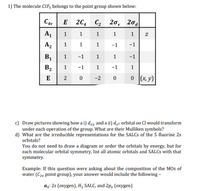
Chemistry
10th Edition
ISBN: 9781305957404
Author: Steven S. Zumdahl, Susan A. Zumdahl, Donald J. DeCoste
Publisher: Cengage Learning
expand_more
expand_more
format_list_bulleted
Question
Help me please

Transcribed Image Text:1) The molecule ClF; belongs to the point group shown below:
C4v
E 2C, C2 20, 20d
A1
1
1
1
1
1
A2
1
1 1
-1
-1
B1
1
-1 1
1
-1
B2
1
-1
1
-1
1
E
0 (x, y)
2 0
-2
c) Draw pictures showing how a i) dy and a ii) d,2 orbital on Cl would transform
under each operation of the group. What are their Mulliken symbols?
d) What are the irreducible representations for the SALCS of the 5 fluorine 2s
orbitals?
You do not need to draw a diagram or order the orbitals by energy, but for
each molecular orbital symmetry, list all atomic orbitals and SALCS with that
symmetry.
Example: If this question were asking about the composition of the MOs of
water (C2, point group), your answer would include the following -
a1: 2s (oxygen), H2 SALC, and 2p, (oxygen)
Expert Solution
This question has been solved!
Explore an expertly crafted, step-by-step solution for a thorough understanding of key concepts.
This is a popular solution
Trending nowThis is a popular solution!
Step by stepSolved in 4 steps with 50 images

Knowledge Booster
Learn more about
Need a deep-dive on the concept behind this application? Look no further. Learn more about this topic, chemistry and related others by exploring similar questions and additional content below.Similar questions
- Hello can I get help with this question soon please?!? I am very confused and do not know where to start. An explanation leading to the correct answer would be helpful. Thank you!arrow_forwardyout References 2 v Font ₂x²A - A V Mailings Review View Help A A Aa AEE ALT Y f3 5 United States) Text Predictions: On O 14 101 === Paragraph Search (Alt+Q) 4.All are correct V Accessibility: Good to go 15 5 1.To the polarity of water and that organic compounds are nonpolar. f6 D Normal Organic compounds tend not to mix with water. What is the reason for this chemical characteristic of organic compounds with water? 2.Because water forms a hydrogen bond and hydrocarbons do not have polarity for this, unless they have an oxygen in the chain. 3.Some alkanes can mix with water if they have a carbonyl or hydroxyl group. No Spacing f7 40 Styles hp 18 Heading 1 19 0 0 f10 F17 5 F12 Find Replac Select- Editing 82°F Mosarrow_forwardcan i get help, i thought this was the answer and its notarrow_forward
arrow_back_ios
arrow_forward_ios
Recommended textbooks for you
 ChemistryChemistryISBN:9781305957404Author:Steven S. Zumdahl, Susan A. Zumdahl, Donald J. DeCostePublisher:Cengage Learning
ChemistryChemistryISBN:9781305957404Author:Steven S. Zumdahl, Susan A. Zumdahl, Donald J. DeCostePublisher:Cengage Learning ChemistryChemistryISBN:9781259911156Author:Raymond Chang Dr., Jason Overby ProfessorPublisher:McGraw-Hill Education
ChemistryChemistryISBN:9781259911156Author:Raymond Chang Dr., Jason Overby ProfessorPublisher:McGraw-Hill Education Principles of Instrumental AnalysisChemistryISBN:9781305577213Author:Douglas A. Skoog, F. James Holler, Stanley R. CrouchPublisher:Cengage Learning
Principles of Instrumental AnalysisChemistryISBN:9781305577213Author:Douglas A. Skoog, F. James Holler, Stanley R. CrouchPublisher:Cengage Learning Organic ChemistryChemistryISBN:9780078021558Author:Janice Gorzynski Smith Dr.Publisher:McGraw-Hill Education
Organic ChemistryChemistryISBN:9780078021558Author:Janice Gorzynski Smith Dr.Publisher:McGraw-Hill Education Chemistry: Principles and ReactionsChemistryISBN:9781305079373Author:William L. Masterton, Cecile N. HurleyPublisher:Cengage Learning
Chemistry: Principles and ReactionsChemistryISBN:9781305079373Author:William L. Masterton, Cecile N. HurleyPublisher:Cengage Learning Elementary Principles of Chemical Processes, Bind...ChemistryISBN:9781118431221Author:Richard M. Felder, Ronald W. Rousseau, Lisa G. BullardPublisher:WILEY
Elementary Principles of Chemical Processes, Bind...ChemistryISBN:9781118431221Author:Richard M. Felder, Ronald W. Rousseau, Lisa G. BullardPublisher:WILEY

Chemistry
Chemistry
ISBN:9781305957404
Author:Steven S. Zumdahl, Susan A. Zumdahl, Donald J. DeCoste
Publisher:Cengage Learning

Chemistry
Chemistry
ISBN:9781259911156
Author:Raymond Chang Dr., Jason Overby Professor
Publisher:McGraw-Hill Education

Principles of Instrumental Analysis
Chemistry
ISBN:9781305577213
Author:Douglas A. Skoog, F. James Holler, Stanley R. Crouch
Publisher:Cengage Learning

Organic Chemistry
Chemistry
ISBN:9780078021558
Author:Janice Gorzynski Smith Dr.
Publisher:McGraw-Hill Education

Chemistry: Principles and Reactions
Chemistry
ISBN:9781305079373
Author:William L. Masterton, Cecile N. Hurley
Publisher:Cengage Learning

Elementary Principles of Chemical Processes, Bind...
Chemistry
ISBN:9781118431221
Author:Richard M. Felder, Ronald W. Rousseau, Lisa G. Bullard
Publisher:WILEY